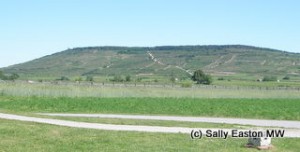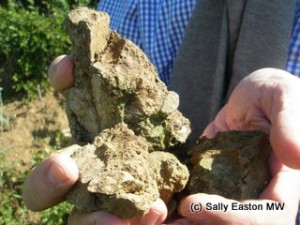Heiligenstein and primary rock
The Heiligenstein is one of Austria’s most famed vineyards, located about an hour west of Vienna in Kamptal, one of the top, white wine producing regions of the country.

Heiligenstein vineyard, Kamptal
This hillside vineyard was first mentioned in the Zwettl abbey register of 1280 as “Hellenstein”, or hell stone, because it was a mountain on which the sun “burns like hell”. It was later renamed Heiligenstein, or “holy rock”, in possibly in an early form of political correctness.
The Heiligenstein is a unique geological formation – a geological island – within Europe, dating to the Permian period some 250 to 270 million years ago, comprising an extrusion of desert sandstone with volcanic and carboniferous conglomerates.
Digging deeper into a more detailed meaning of ‘primary rock’ or ‘urgestein’ reveals many layers. “In ancient times there were very high mountains here.” explained Willi Bründlmayer of the eponymous Kamptal estate Weingut Bründlmayer. “There was an erosion of 300-1,000m, which left some rock stumps. These rock stumps are primary rock. The rocks are silicate, gneiss, granite, amphibolites. Then 250 million years ago, erosion residues and volcanic material and vegetation residues had built up. Later this mixed material compressed over a long time, and changed to soft rock. This was then pushed up again tectonically. What remains are Heiligenstein and Lamm vineyards.

Willi Bründlmayer holding primary rock
Hannes Hirsch of the eponymous estate Weingut Hirsch, added that after the “volcanic activity there was consistent vegetation 250m years ago which left roots and leaves, layers and layers of which built up. A shallow ocean then came in, then tectonic movement which pushed out the Permian material again.”
This complex ancient geology plus centuries of viticulture have resulted in a detailed map of vineyards matched to grape variety, mostly either riesling or grüner veltliner, which now account for 80% or more of plantings in Kamptal. Bründlmayer said “Heiligenstein is more to the west, cooler, poorer, and better adapted for riesling. There’s no grüner veltliner. Lamm has a layer of chalk-rich loess and loam, it’s a richer soil, warmer. It’s suited to rich styles of grüner veltliner.” The Lamm vineyard, lying on the lower slopes below the Heiligenstein vineyard, has a primary rock base underneath the loess and loam.
Bründlmayer added “riesling is better planted directly in the primary rock, and grüner veltliner prefers the addition of some rich material – sediment, loam, loess.”

Detail of Kamptal vineyards
The Gaisberg vineyard, to the immediate south-east of Heiligenstein, marks the end of the ancient massif coming down from the north, and is founded on primary rock of gneiss and mica-schist. Hirsch said: “you can break it up, it’s schistous with a brown earth layer. And the eastern part of the vineyard has a loess covering, which came from the east”. Gaisberg is often planted to riesling.
Heiligenstein and ‘primary rock’ are only ever spoken in the same breath, but primary rock is a term used elsewhere for soils coming from this very old rock. Much of nearby Wachau has granite and gneiss primary rock at its foundation, and the primary rock soils have been divided into the three main camps of granite, gneiss and slate.
Over the geological time of millennia, rocks have been variously heated, cooled, compressed and tectonically moved. Granite is a mineral-rich rock formed of molten material. Gneiss can be formed by changes in heat and pressure. Slate can be the product of sedimented erosion material which has been metamorphosed by heat or pressure.
Soils derived from primary rock are often thin and low in organic matter and fertility, a layer of crumbly rock at the surface with the bedrock 20 to 30 cm below.
The importance of primary rock is the structure and flavour profile found in the wines. Primary rock is strongly argued to confer ‘minerality’ into the wines. Bründlmayer said: “On the rocky hillsides, grape berries are smaller. It’s not about the 3, 4, 5 principal elements, it’s about the hundreds of elements. Heiligenstein is silicate with an acidic element and 250 million year old organic matter. Roots take many different minerals in many different micro-doses. It contributes to a wine.”
As yet though, exactly, scientifically, how those mineral-laden rocks confer minerality in wine is yet to be unearthed, as it were. Read here for a discussion about minerality.



